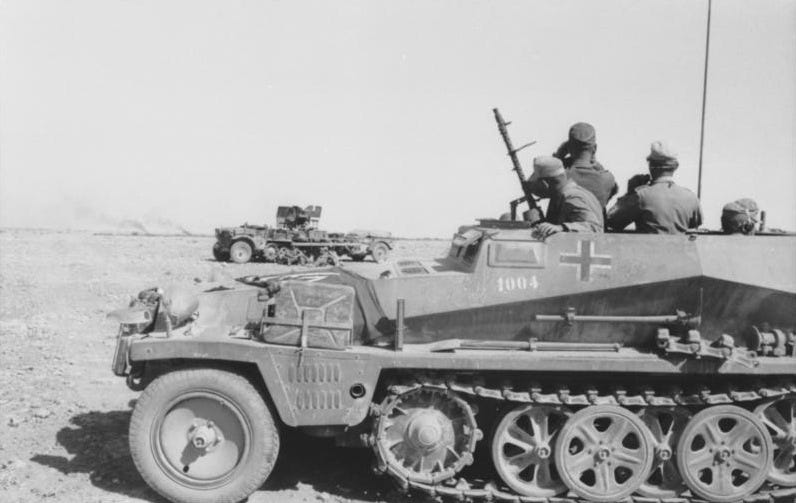British struggle to respond to Rommel
27th May 1942: In the North African desert British forces are shocked to encounter the massive German infiltration
Rommels surprise overnight advance around the base of the British lines had gone well. On the morning of the 27th he was strongly placed to attack British positions behind the main Gazala line. The nature of British “defensive boxes” established in the desert meant that this was not the same as being behind their “front line”. Provided these ‘boxes’ could be supported there was not necessarily a great advantage in attacking from a particular direction.
Nevertheless surprise was complete and Rommel was given further advantage by the complacent and confused response of the British senior command. They took a long time to comprehend just how large a force now threatened them from a completely unexpected direction.

‘There is a cloud of dust to the south; it has the appearance of a military formation.’
Lieutenant D.F. Parry1 was commanding a mobile repair workshop close to the front line and overheard the following radio exchange
It was about 0800 hours when, failing to raise my regimental headquarters, I ordered my wireless operator to search adjacent bands in case the wavelengths had been changed without our knowledge.
Almost immediately we picked up a transmission ‘in clear’, a little unusual as all messages were passed in code prior to a battle. Clear and concise, it was like a BBC outside broadcast; even after thirty years the conversation is as sharp today as it was in 1942.
The officer, obviously well south, was sending a message to XXX Corps HQ at El Adem.
Officer: There is a cloud of dust to the south; it has the appearance of a military formation.
Reply from XXX Corps: There are no, repeat no, troops to your south. However, 7th Armoured Division is positioned to the west.
Officer: The cloud of dust is growing larger. It is undoubtedly a military formation.
Reply (slightly irritable)-. We repeat, there are no, repeat no, troops to your south.
Officer: Through the haze I can now identify tanks, difficult to identify but possibly German Mark IVs.
Reply: We repeat, there are no troops, repeat no troops, to your south.
Officer: I can now positively identify German Mark IV tanks together with motorized infantry; it appears to be a large German force.
Reply (irritably): We repeat no, repeat no, forces in your vicinity.
Officer: I am counting Mark IVs - one, two, three, four, five, six, seven - there is no doubt, repeat no doubt, that this is a large German force. Mark IVs number over thirty, and there are also Mark IIIs and a large number of motorized infantry. This could be, I repeat, this could be the Afrika Korps moving at a speed of approximately 30 miles per hour towards El Adem.
Reply (with air of resignation): There are no forces in your area.
Officer: I have been spotted by the enemy and am under fire. (In the under fire.
(In the background one could hear the ominous sound of exploding shells. However, our intrepid broadcaster’s tone did not change one iota from start to finish.)
I repeat, it is a large enemy formation and probably the Afrika Korps moving fast northwards. °
Reply (very bored): There are no enemy forces in your area.
Officer: It is undoubtedly the Afrika Korps moving at speed towards El Adem. I am under...
Then there was silence.

The large cloud of dust was the first sign of something amiss and there are many accounts from those who were completely shocked when they went to investigate.
‘The next round came straight inside the armoured car. I didn’t realise it had hit us, and I turned and there were two radio operators without heads - absolutely nothing from the shoulders.’
Bobby Feakins2 was with the Royal Horse Artillery, on the 27th he drove his battery commander out to discover what was going on:
The battery commander, Major Gerry Birkin, went out in an armoured car used as a mobile OP to investigate reports of German armour moving down in the south. He was up in the turret and sighted a lot of dust, and said, ‘Would you just check this?’
I went up and a shell landed a bit behind us. He said, ‘Whoops.’
Then I said, ‘Oh sir! Quick!’ I thought I’d seen a vehicle moving in direct line towards us. I came down and sat in my seat, and he went up.
The next round came straight inside the armoured car. I didn’t realise it had hit us, and I turned and there were two radio operators without heads - absolutely nothing from the shoulders. I had blood and muck all over me.
Major Birkin slumped into my arms and he was actually dead at that point, hit right in the tummy. I was wounded in the legs. On the interbattery wireless, I said, ‘We’ve been hit. We’ve been hit.’
This account appears in The Imperial War Museum Book of the Desert War, 1940-1942 .
Driver Bobby Feakins, 107th (South Notts Hussars) Field Regiment, Royal Horse Artillery, this account appears in Forgotten Voices Desert Victory.




